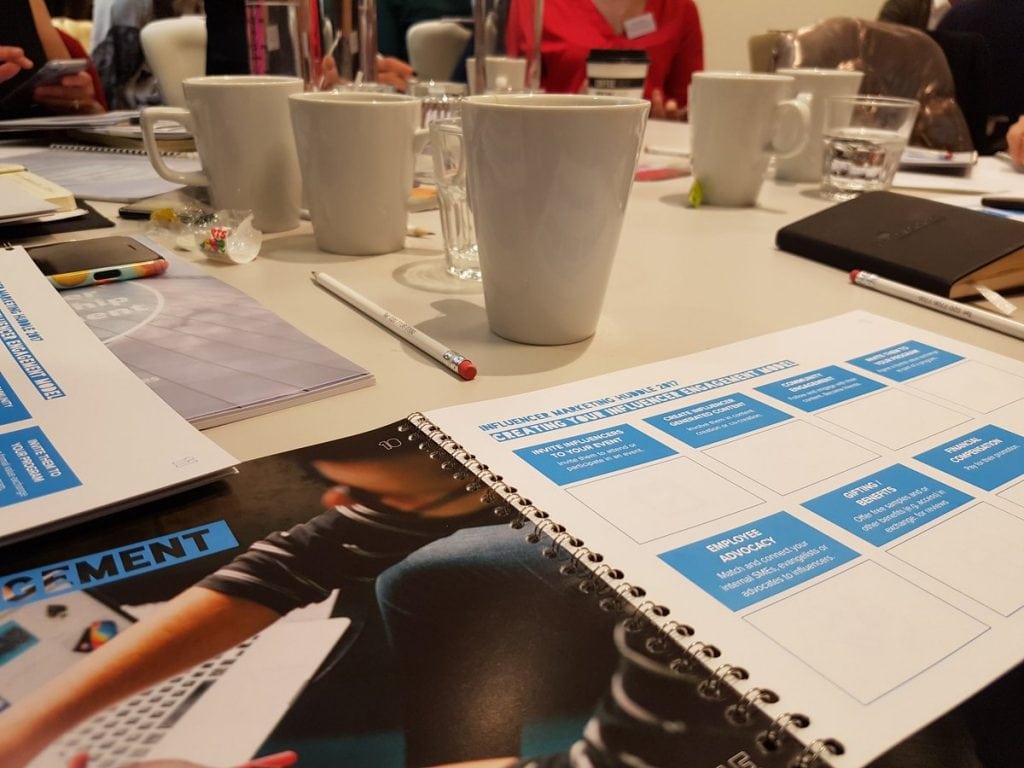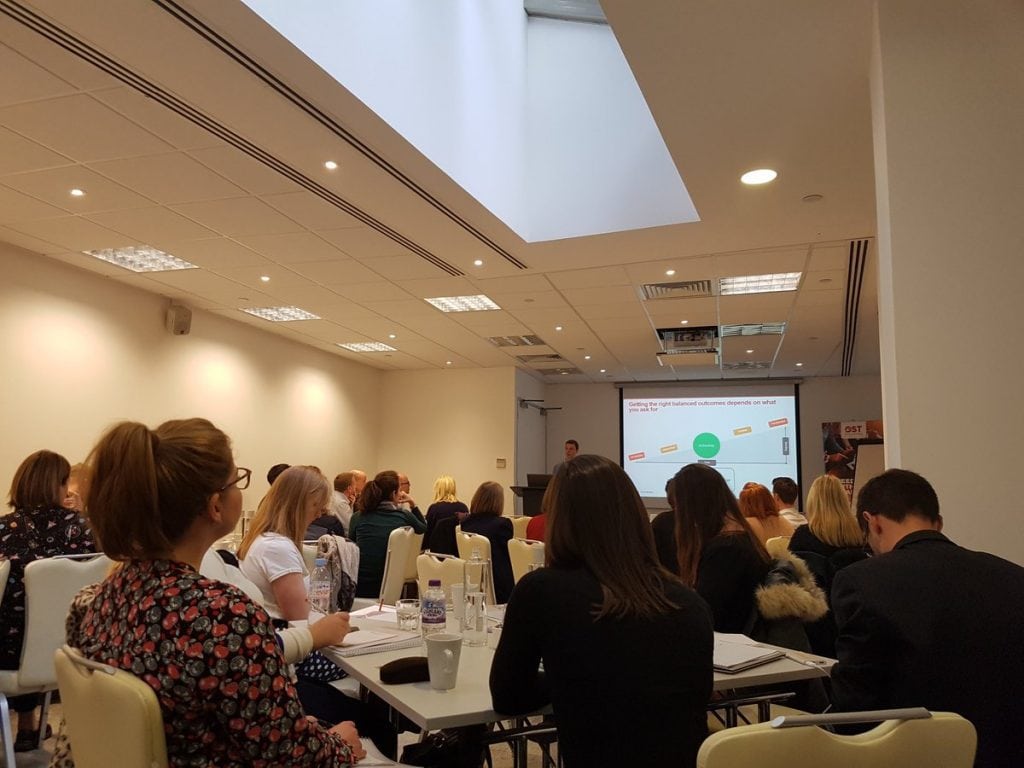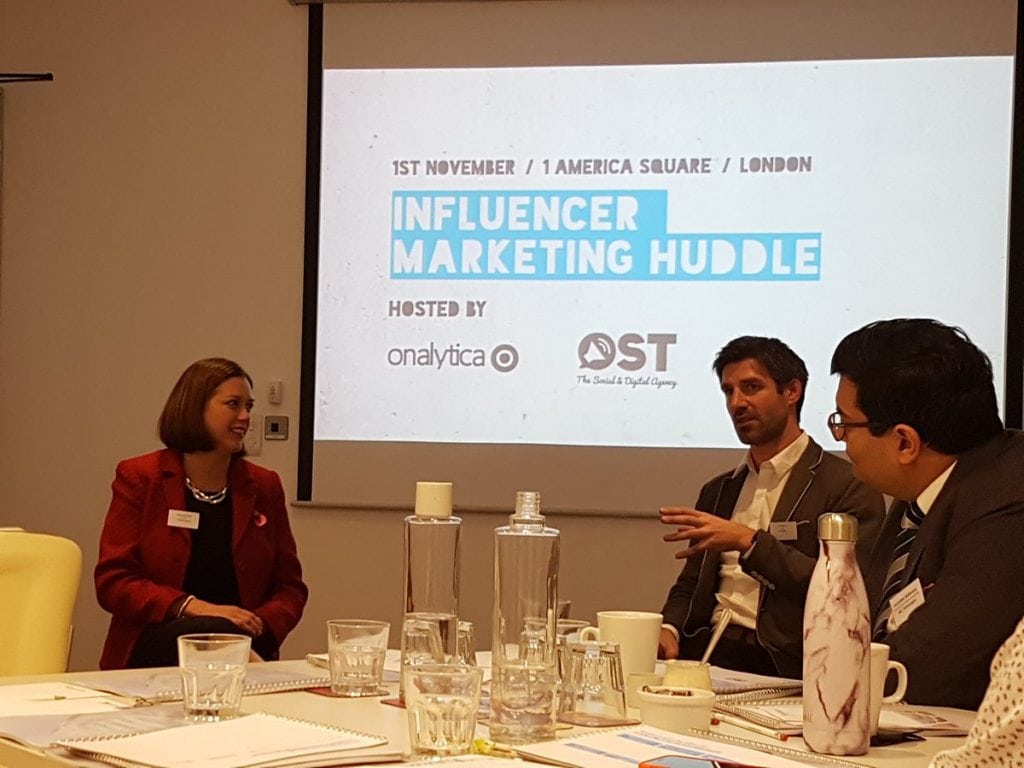Yesterday, we co-hosted our second Influencer Marketing Huddle workshop with OST Marketing here in London. As the name suggests, it’s a practical, hands-on event where we gather senior B2B and B2C marketers from various sectors ranging from tech to charity, in the same room to put their heads together to learn, share their stories (both good and bad) and come away feeling better informed and substantially more inspired.
Our first huddle was focused around getting started, while yesterday was more geared around identifying and engaging with influencers – the make or break stage of influencer marketing that too many continue to get wrong.
In amongst our two practical round table workshop sessions we had educational presentations from:
- Tim McLoughlin, Global Head of Social Media at Hotels.com – How Hotels.com have used influencer marketing to transform their brand perception and target millennials
- Alistair Wheate, Head of Influencer Marketing Solutions at Onalytica – How you can identify and segment your influencers using keywords
- Ryan Visser, Head of Social Media at VMware – How VMware are effectively working with B2B influencers
- Luke Brynley-Jones, Managing Director at OST Marketing – The 7 main engagement models for working with influencers
- Tim Williams, CEO at Onalytica interviewing Sarah Goodall, Founder of Tribal Impact – The importance of employee advocacy and how this links in with influencer marketing
Here are the key takeaways from the morning.
It’s ok to make mistakes. In fact, it’s GOOD to make mistakes
While mistakes are frustrating in the moment, the lessons learnt are extremely valuable and often contribute greatly to future successes. Tim McLoughlin shared with us how Hotels.com have been learning as they go along on: formats, styles, level of branding, outcomes & KPIs and the scope of freedom for influencers. When Hotels.com first started out with influencer marketing, they used to send influencers off to different locations and give them total free reign with their visit and their content produced from it, in the hope that the influencer’s content would effectively promote the location. However, they’ve had experiences where influencers haven’t quite stuck to the brief, and were slightly more tied up posting selfies – in turn not producing very valuable content – what seemed like a total loss at the time.
But because of these mistakes, they’ve since managed to achieve a beautifully artistic video in which they sent a talented film crew with a small group of influencers to Bordeaux, to create a 3 minute video which can be chopped up and re-purposed. This video would not have been such a success had they not made their mistakes early on in their influencer journey.
Harmonise your objectives with other teams’ objectives
Every brand has a tone of voice and image they’re hoping to portray. Your advertising, PR and social teams’ objectives should all be harmonised and geared towards achieving this. A brand’s tone of voice can be very effectively portrayed through both your influencers and your staff members.

There are identification keywords and listening keywords
The keywords you use to identify your influencers may not be the same as the keywords you use to analyse your influencers’ conversations. Keywords that matter to your brand may have more than one context in which they’re used. Use broader terms to identify your relevant influencers, then track their engagements against the most specific terms.
E.g. a brand looking to track influencer conversations around the keyword “privacy” in the context of “cybersecurity”, would get very irrelevant results with varying contexts if they were to identify their influencers against the broad keyword “privacy”. Identifying their influencers using the keyword “cycbersecurity” however, and inputting keywords such as: privacy, infosec, data protection and ransomwear into a program to track influencer engagement, would bring back focused, quality data.
Follower numbers do not = reach
An influencer’s follower numbers does not correspond to their reach. A post is not guaranteed to reach every single one of their followers, nor is every single one of their followers likely to be relevant to your brand. If you have defined your target demographic according to age, gender location and interests – what proportion of your influencers’ audiences fit this? Do your research and do not fall into the trap in which you’re too focused on follower numbers.
Use influencers for their creativity, credibility and reach
Emphasising on the above point, influencers not only offer access to their audiences, but they have a wealth of knowledge and creativity. Understand your influencer’s unique qualities and leverage them in your partnership!
Define your partnership
Often brands approach influencers having only thought about what they want from the influencer, so when the influencer asks ‘what’s in it for me?’ they’re not quite sure how to respond. It is imperative that you understand why influencers would want to work with you, beyond just a pay cheque. What has your brand got to offer? Clearly outline this at the beginning of your partnership so that neither party are done a disservice.
Focus on long term relationships
Influencer marketing done with a campaign mindset does not work. It’s all about building long term relationships through an always on approach. Influencers must be invested in your partnership and share your vision.
“I still play Xbox with influencers I worked with back in 2007. Influencer marketing is all about genuine, long term relationships.”
Ryan Visser, Head of Social Media at VMWare

Aim for content that has long term value
A paid for Instagram post may deliver short term value, but eventually your paid for #ad post will be yesterday’s news and be replaced by today’s ad. Creating long form blog posts and video content will continue to provide value and can be re-purposed for far longer, such as Hotels.com Bordeaux video.
Brief your influencers like agencies
When working with an agency, you provide a brief outlining what it is that you expect from the partnership, without actually doing the work for them. This is because you understand they’re the experts and trust them. The same goes for influencers – set your expectations & requirements and then let their expertise and creativity do the rest.
Ensure your influencers’ content remains authentic
You’re working with an influencer because you want access to their audience and creativity, right? So why would you try and change what drew both your brand and their audience to them in the first place? Their content must remain in line with their personal brand and content style; disrupting this content style risks detriment to both their brand and yours.
Engage with few, track many
Engaging with hundreds of influencers with the aim of building relationships with them all will not work. This is not to say that you should not identify the wider influencer community. Adding hundreds of influencers to a program and understanding what they care about and how they speak is extremely important and insightful. Use this intelligence to build relationships with your core influencer targets.
VMware monitor 1200 influencers in their program, but only engage with 73.
Think like a radio station
This analogy came from Ryan Vissner at VMware. We listen to our radio station of choice because we like the music that they play; we are ok with the occasional advert slotted in between songs. If suddenly, all they played were adverts, we’d stop listening. Influencers’ audiences like their content and trust their opinion. If suddenly their feeds were filled with ads, their followers would lose interest.
Include influencers in your demand gen funnel
VMware include influencers in their demand gen funnel, by directing traffic (organically and paid) to their influencers’ blogs where their call to action is hosted. This is an extremely smart method that is responsible for WMware’s increase in conversion click through of 70%.
The 7 main engagement models
- Community engagement (follow and engage with their content.)
- Employee advocacy (match and connect your internal SMEs, evangelists or advocates to influencers)
- Invite influencers to your event (invite them to attend, host or participate in an event)
- Create influencer generated content (involve them in content creation or co-creation)
- Invite them to your program (Agree a formal value exchange as part of a program)
- Gifting/benefits (offer free samples or access and or other benefits for reviews)
- Financial compensation (pay influencers to promote your products/services)
Sarah Goodall on employee advocacy

Think employee first – why should they want to do this?
Sell the benefits that this will have to them personally, not just the benefits that this will have on the business. Highlight that this will help them build their personal brand and will broaden their network and accelerate their career.
Lead by example – get senior execs on social
Often employees are uninspired and apprehensive to get on board with employee advocacy – they’re not sure of the boundaries. Senior management leading by example will give other employees the go ahead, set the boundaries and spark motivation to do the same.
Nail training, tools and content
Train your employees (both on the why and the how) and provide them with the tools and content to make the process as easy as possible.
Advocacy programs must be holistic
Employee advocacy is not owned by one department – it isn’t just a marketing exercise. Employee advocacy must span across all business functions.
Employee-generated-content is valuable and cost efficient
Employees do not like sharing branded content anywhere near as much as they like sharing their peers’. Get your employees involved in content creation. Tim McLoughlin explained how Hotels.com used to spend a lot to have access to stock images to populate their Instagram – none of which were exciting or original. They stopped this and started to include their employees’ own pictures on their Instagram.
The results were: more real, better quality, cheaper photos.
Sarah highlights that it’s important to let your employees post what they’re passionate about. Being too corporate and branded defeats the whole purpose.
If you’re interested in attending our next influencer marketing huddle, get in touch by clicking the button below, or email me direct at alicia.russell@www.onalytica.com.
